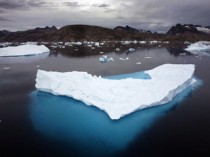World Climate Report
In this week’s Science magazine, science writer Richard Kerr reports on some of the goings-on at this past December’s annual meeting of the American Geophysical Union. While he didn’t cover our presentation at the meeting in which we described our efforts at creating a reconstruction of ice melt across Greenland dating back into the late 1700s (we found that the greatest period of ice melt occurred in the decades around the 1930s), Kerr did cover some other recent findings concerning the workings of Greenland’s cryosphere in his article titled “Galloping Glaciers of Greenland Have Reined Themselves In.”

Here is how Kerr starts things off: “Things were looking bad around southeast Greenland a few years ago. There, the streams of ice flowing from the great ice sheet into the sea had begun speeding up in the late 1990s. Then, two of the biggest Greenland outlet glaciers really took off, and losses from the ice to the sea eventually doubled. Some climatologists speculated that global warming might have pushed Greenland past a tipping point into a scary new regime of wildly heightened ice loss and an ever-faster rise in sea level.
And some non-climatologists speculated disaster from rapidly rising seas as well. During his An Inconvenient Truth tour, Gore was fond of spinning the following tale:"[E]arlier this year [2006], yet another team of scientists reported that the previous twelve months saw 32 glacial earthquakes on Greenland between 4.6 and 5.1 on the Richter scale - a disturbing sign that a massive destabilization may now be underway deep within the second largest accumulation of ice on the planet, enough ice to raise sea level 20 feet worldwide if it broke up and slipped into the sea. Each passing day brings yet more evidence that we are now facing a planetary emergency - a climate crisis that demands immediate action to sharply reduce carbon dioxide emissions worldwide in order to turn down the earth’s thermostat and avert catastrophe.”
Oh how things have changed in the past 2 years. Gore’s “massive destabilization” mechanism for which the earthquakes were a supposed bellwether (meltwater lubrication of the flow channel) has been shown to be ineffective at producing long-term changes in glacier flow rate (e.g. (Joughin et al., 2008; van de Wal et al., 2008). And for still another, the recent speed-up of Greenland’s glaciers has even more recently slowed down.
Here is how Kerr describes the situation: “So much for Greenland ice’s Armageddon. “It has come to an end,” glaciologist Tavi Murray of Swansea University in the United Kingdom said during a session at the meeting. “There seems to have been a synchronous switch-off” of the speed-up, she said. Nearly everywhere around southeast Greenland, outlet glacier flows have returned to the levels of 2000.
All told, it is looking more like the IPCC’s estimates of a few inches of sea level rise from Greenland during the 21st century aren’t going to be that far off- despite loud protestations to the contrary from high profile alarm pullers.
Maybe Gore will go back and remove the 12 pages worth of picture and maps from his book showing what high profile places of the world will look like with a 20-foot sea level rise ("The site of the World Trade Center Memorial would be underwater"). But then again, probably not - after all the point is not to be truthful in the sense of reflecting a likely possibility, but to scare you into a particular course of action. Read full report here.


